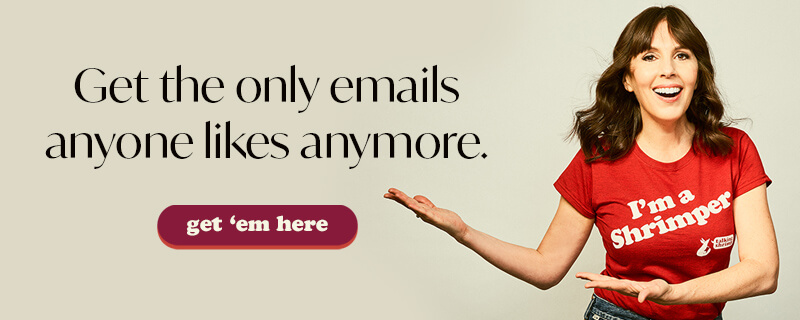I’m about to shove a stick of dynamite into a big ol’ excuse, and light it. RUN!
(Cut to me walking away calmly, with a small mushroom cloud exploding behind me.)
The excuse, I mean, very good question is:
“Oh sure, Laura Belgray, easy for you to always tell fun stories in your emails, posts, and captions – you live in New York! And all kinds of crazy things happen to you, with all the pimps and prostitutes and scam artists and hot clubs and the ghost of Andy Warhol! But me, I live in Bumfudge, USA. Plus…
“…I’m a boring person with a boring life. What am I supposed to write about?”
I’m not making that up. I got the almost exact question in an email from a Shrimper named Ruth:
Laura, I love reading your emails and you’re right- I open and read every stinkin’ (said with so much love) one. But…what if you live in a small town in central Pennsylvania where nothing even remotely interesting happens. You are able to tie in your life experiences with your messaging, I haven’t been able to do that. Am I looking at it the wrong way?
Um, yup. You think nothing remotely interesting happens in a small town? To that I say:

There’s a reason I picked a gif from The Office.
(Note to self: insert gif AFTER writing post. So distracting!)
The Office ran for 9 seasons, or 201 30-minute episodes.
That’s a lot of stories.
Guess where The Office takes place.
New York? Nope. Hollywood? Nope. Gay Paree? Je ne pense pas.
The Office takes place in Scranton, Pennsylvania.
Yeah, it’s a city. But most of it takes place in a thuddingly dull office park.
Wherever you are, you’re surrounded by stories. Even if you don’t leave the house.
What makes for a good story?
Some kind of conflict or friction —
- between people (fight, disagreement),
- between what someone wants and what they have (struggle, challenge, problem),
- between expectation and outcome (surprise),
- between what we know and what we want to know (curiosity, mystery).
Think about it.
If I told you, “Yesterday, everything went as expected. I got my iced coffee, answered emails, wrote a stellar email to my list, had lunch, watched some Bravo reruns, went to dance class, and then ordered a late dinner,” you’d be like, “Yeah…?….and then?”
You’d be waiting for a twist. A point. Otherwise, not a story.
It needs some kind of conflict or friction. But that exists all around you.
Want examples? Here are…
7 types of “conflict” setups for compelling stories
1. Two people wanting opposite things.
For instance, one soccer mom wants all the kids to get trophies.
The other soccer mom wants only her kid, who’s a star athlete, to get a trophy.
And…go!
2. Two or more people wanting the same thing.
- Think of the stories that go down at doorbusters on Black Friday! Some come out of Walmart with flatscreens, some with gushing head wounds, and resulting brain damage. Some with both!
- Think of when your boyfriend says marshmallows have a high fat content and you say they have zero fat, and it turns into a huge blowup where he even refuses to look at the google answer on your phone. You both want the same thing: to be right!
3. One person wanting something, but there’s an obstacle.
- You’re on a deadline and want/need to focus but the neighbors upstairs built a “drum room” for their freaking 4-year-old right above your office.
- The airline won’t let you change your flight online, but there’s a 4-hour wait to speak to a customer service agent.
- Your friend is struggling to get his rebellious tween out of bed for school every morning.
4. Everyday problems
- The toilet overflowed, in biblical proportions.
- Your dog keeps eating your designer shoes.
- You know you should go to this party but you no longer like leaving the house.
- You’re upset that your favorite jeans are officially out of style and low-rise, which you hated the first time around, are back.
- A friend who’s a colossal slob asked if they can stay with you for a few nights and you don’t know how to tell them no.
5. Mistakes
- When your computer freezes and you google Apple support, call the number at the top, have the guy walk you through a whole cleanup of your mac, give him your credit card number to finish because it turns out you don’t have AppleCare, and then you realize you didn’t call Apple, you called some sketchy guy who paid for the top sponsored listing on google, which, in your panic, looked legit.
- You neglected to check the expiration date on your passport ’til the week of the trip. Uh oh.
- You thought you were grabbing a free cupcake, but it turned out to be soap shaped like a cupcake.
6. Dilemmas
- You saw your best friend’s husband making out with the checkout worker at the WaWa. But if you tell your friend, she’ll probably stop being friends with you and keep her cheating husband. Do you tell?
7. Mysteries
Who keeps stealing your morning paper? WTF?
(OK, you want a positive one? How’s this: Why do you keep finding 20 bucks practically every time you look down at your feet? Or this one: How did you suddenly become a “morning person” after years of being a late sleeper? I WANT TO KNOW)
You get my drift.
None of these things require a big-city setting or a glamorous or crazy life.
It doesn’t even have to be people.
You can have conflict between two raccoons, or between a house that wants to remain standing and a sinkhole that has other ideas.
Know what? It doesn’t have to be about you, either.
You think you’re boring? OK. But you can observe and report interesting things.
Life is full of stories, no matter where you live.
Even if you don’t leave the house. Think how many times I’ve mentioned Real Housewives!
But wait, I know you’re still wondering this:
How do you connect the story to your messaging or a Call To Action (CTA)?
There’s an art to it, which I demonstrate in both The Copy Cure and Inbox Hero.
For starters, you can try a basic segue like, “Why am I telling you this? Because ___________.”
For instance: “Why am I telling you this? Because when you’re focused and present, you don’t make sloppy mistakes like calling the first number you see at the top of the google page and end up giving them all your money. Here’s the best way I know to get more present and focused in your life.”
Or how about:
“Why am I telling you this? Because I’m feeling a little smug and above it all, wearing this beautiful silk scarf. Life is full of little battles, but looking put-together isn’t one of them when you can top off your outfit with one of these.”
Want to integrate it more seamlessly?
Draw a conclusion, and talk about how it relates to what you’re offering or want the reader to do.
Example:
I wrote an email. Subj: How to ask for things
It was about needing basil after the store closed, and having no one around we could ask for some because we didn’t know our neighbors. Here’s the segue to the CTA:
This is what happens when you haven’t been building relationships.
There’s no one you can ask for shit when the store is closed.
The online business equivalent?
Having no subscriber list and then trying to launch something.
Or, being so infrequent with your newsletter that your subscribers forget who you are….
….and reaching out only when you have something to sell.
Even the best e-commerce businesses, which are always selling, use personality and some kind of storytelling to build resonance and a rapport with you.
Want to write stories that get your subscribers to devour your emails and pounce on your offers?
Story Hero, my brand new training on storytelling for emails, is coming soon!
It’ll be the basil in your stories, taking them from good (or even just OK) to great.
Click here to get on the first-to-know list.
See that? The segue to a takeaway is “This is what happens when…”
And I tie it to the CTA with the analogy, “The online business equivalent?”
Tying your stories to a CTA is all about creating a link between two ideas.
Sometimes you have to dig for that link, sometimes it’s right there.
If you really want to get the hang of connecting stories to a message or CTA, start by signing up for my emails. Watch and learn!
Now you.
Do you have trouble coming up with stories? Do you think you have to live in The Big City or have a “wacky personality” to be surrounded by them?
Or, what ingredient do you think makes for a story?
TELL ME IN THE COMMENTS.
ps – If you can leave the house, I recommend that you do. At least once a week. Get out there!
pps – Also recommend taking out your earbuds once in a while. That’s how often I do it. Eavesdropping (the best source of stories) is way more effective when you can hear.


First things first, I swear you’re aging in reverse, Laura. I saw you years ago in Marie F’s Course, and now I see these “Pepper” style ads I’m thinking, “is Laura aging in reverse like some kind of sassy Benjamin Button?”
Second, your posts inspire me to write the way I talk, and I talk like a clever sonnofagun, so my email content gets a lotta praise thanks to you.
Great examples, thank you!
Laura,
I love this post! It has a great set of examples to illustrate common situations to go with the classic conflict types. Thank you for (yet again) giving me light hearted inspiration for things to write about.